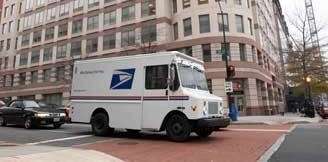When my family moved from Pittsburgh to a town in the Boston suburbs in the mid 1960s, we noticed two old-fashioned things about the town — other than the fact it was dry, with neither tavern nor “packie.”
One, it had a round concrete platform in the middle of the main intersection near the town square. A police officer would stand atop the platform to direct traffic until a traffic light came a few years later. Second, it had a grocery store store where clerks would pull your items and bring them to the register. By 1965 this was a rarity in grocery retailing, but that store eventually gave way to the self-service model.
This all came to mind when trying to decipher new Postal Service regulations. Specifically, USPS has rewritten Section 63 of the Postal Operations Manual.
In old-fashioned America, the mailman — it was rarely women in those days — delivered mail to your door. Our mailman was of Native Hawaiian decent and he was almost part of the family. As I grew up, he’d warn me when my college mailed home a report card in the summer. Once he chortled, “Hey, you made Dean’s List!” (He didn’t open an envelope. The report card was a 3270 mainframe printout with our address on the reverse side.)
Privacy, schmivacy.
Now, USPS has reinforced what has actually been long-standing policy. No, not that the letter carriers can read your mail. They probably see Bed Bath & Beyond flyers in their sleep. That policy is to do away with, to the extent possible, door-to-door delivery. USPS strongly prefers “cluster box units,” those panels of mailboxes situated at common areas of many neighborhoods. USPS first introduced CBUs in 1967. In the rewording, the agency said only in “rare exceptions” would it grant new developments permission for traditional delivery.
USPS needs money-saving efficiency. It always has, but nowadays it’s more urgent. The service is losing billions of dollars a year. Curbside mailboxes are less efficient for delivery, as are at-the-door boxes and mail slots.
Thus the Postal Service is caught in the 21st century irony. Automated, electronic service — digital service — is becoming more personalized. In-person service is growing less personal. USPS offers a daily email program so recipients can see what mail is arriving later that day. You can see if that check or wedding invitation will arrive. But fewer home dwellers see the person actually delivering them.
A few years ago, a rumor circulated in my neighborhood that the local postmaster wanted us to install a CBU and get rid of curbside mailboxes. I could see the point from USPS’ standpoint. An hour parked by the CBU would save probably three hours snaking through the neighborhood. Multiply that across the nation and you’re looking at billions of man-hours.
Yet the logical place for the CBU in my case would be where the neighborhood empties out to a busy street. The light there backs up a lot of cars. I can only imagine the annoyance caused by 400-odd homeowners stopping to fetch mail.
A spokesman told GovExec that USPS was merely clarifying existing policy. But it reads like an agency about to take on more mailbox huggers.
Copyright
© 2024 Federal News Network. All rights reserved. This website is not intended for users located within the European Economic Area.
